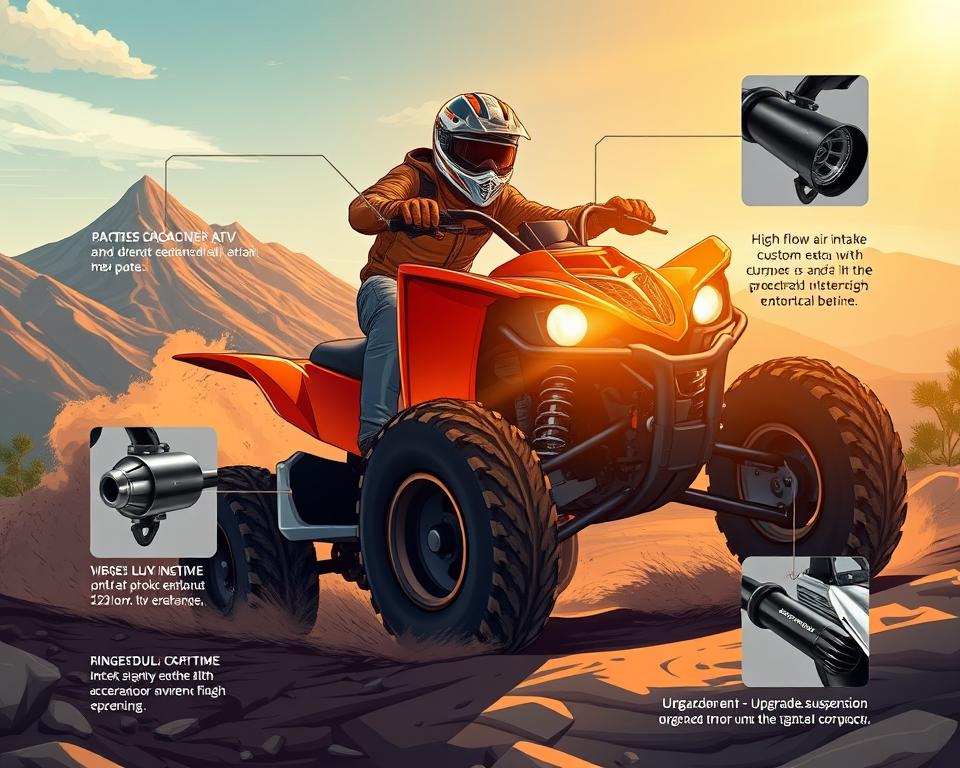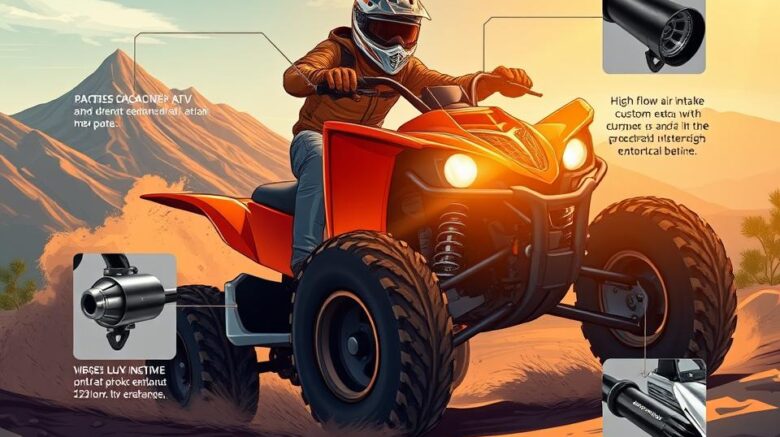Essential ATV Off-Road Checklist for Safe Riding
Did you know nearly approaching half a million ATV-related injuries are treated in U.S. emergency rooms each year? This alarming figure highlights the need for safety and preparedness in off-road adventures. Here’s your go-to ATV Off-Road Checklist for maximum safety and enjoyment. From boulder-strewn tracks to shifting sands—it’s got you covered. Armed with proper safety equipment and can-am x3 windshield with wiper must-haves, you’ll reduce hazards and amplify the fun.
Significant Points
- Prioritize safety by using the Essential ATV Off-Road Checklist for optimal preparation.
- An ATV safety gear checklist is vital for protecting yourself during off-road rides.
- Keep your ATV running smoothly with routine care.
- Stay fueled and hydrated for peak performance.
- Don’t wander: rely on trusty navigation tools.
- Pack layers and waterproofs for all conditions.
- Always carry essential tools and recovery kits for on-trail repairs and emergencies.
Understanding the Importance of Safety Gear
When you ride off-road, safety must come first. ATVs deliver thrills—and risks. Protective equipment shields you from crashes and bumps. A full gear check means a safer outing.

Essential Protective Gear
Maximizing protection involves several key items:
- Helmets: Always use a DOT helmet to guard against head trauma.
- Eye Protection: Block dirt and grit with quality goggles.
- Gloves: Wear durable gloves for better grip and hand protection.
- Footwear: High boots shield your feet and ankles.
- Protective Armor: Chest and back armor add vital protection.
- Neck Protection: A neck brace protects your spine in a crash.
Emergency Preparedness
Being ready for emergencies is critical. An effective emergency kit can be a lifesaver in unexpected situations. Key items to include are:
- First aid kit
- Multi-tool
- Tire repair kits
- Portable air compressors
- Emergency blankets
- Whistles
- Matches
ATV Equipment for Optimal Performance
Gear choices affect how well your ATV runs. Knowing the must-have ATV equipment ensures you’re ready for any journey. Use this maintenance checklist to keep your ride healthy.
Must-Have ATV Equipment
- Durable Tires: Invest in tires designed for various terrains to improve traction and handling.
- Storage Solutions: Keep tools and spares within reach.
- Quality Fuel Tank: Never run low—use a proven fuel tank.
- Medical Kit: Prepare for emergencies with a well-stocked first aid kit for immediate attention if needed.
Regular Maintenance for Longevity
Establishing a consistent maintenance routine is vital. Regular inspections should encompass:
- A clean air filter = a happy engine.
- Grease your chain often to avoid skip and wear.
- Test your brakes on every pre-ride check.
Stay on top of upkeep and your ATV will perform its best.
The Essential ATV Off-Road Checklist
Preparing for a ride is more than just hopping on your ATV. An effective ATV maintenance checklist ensures your vehicle’s safety and performance. Every point matters—don’t rush. A thorough pre-ride assessment is key to a safe outing.
Pre-Ride Inspection Basics
Before any off-road journey, a pre-ride inspection is vital. Find and fix small problems before they grow. Key elements to check include:
- Tire pressure and tread condition
- Fluid levels such as oil and fuel
- Brakes and controls functionality
- Operational lights and horn
- Chain or driveshaft integrity
T-CLOC Inspection Method
The T-CLOC method offers a systematic approach to inspection. Tires, Controls, Lights, Oil/Fuel, Chain—don’t miss a spot. This method ensures all critical areas are covered:
| Inspection Area | Checklist Items |
|---|---|
| Tires and Wheels | Check tire pressure, inspect tread depth, look for damage |
| Controls | Test brakes, throttle, and clutch for smooth operation |
| Lights | Ensure headlights, brake lights, and indicators are functioning |
| Oil and Fuel | Check oil level, inspect for leaks, and fill fuel tank |
| Chain/Driveshaft | Examine for wear, proper tension, and lubrication |
Spending a few minutes on this ATV maintenance checklist can make rides safer and more enjoyable. Prevent roadside repairs with a fast check.
Hydration and Nutrition for Long Rides
Stay fueled and hydrated for peak performance. Dehydration slows reaction and focus—pack extra water. Carry extra water to prevent fatigue and keep energy levels up during the adventure. The right snacks are also key for maintaining stamina on the trail.
Importance of Staying Hydrated
Hydration is critical for ATV riders to stay alert and capable throughout their journey. It’s important to drink water consistently, not just when thirsty. Hydration bladders track consumption at a glance.
High-Energy Snacks to Pack
Choosing the right snacks is vital for extended ATV rides. Choose items that won’t spoil in heat. Some ideal choices include:
- Protein bars
- Nut mixes
- Dried fruits
- Beef jerky
These snacks provide a quick energy boost without hindering the riding experience. Ensure to pack a variety to keep your energy levels high and your taste buds satisfied.
Navigation Tools for Off-Roading Adventures
Stay on course with proven navigation aids. Off-road navigation tools are invaluable for staying on track, no matter the terrain.
Advanced GPS Systems
High-end GPS units guide you through the wild. Choose units with rugged builds, offline charts, and extended runtime. Garmin and TomTom lead the pack for trail GPS.
Traditional Navigation Aids
Technology is key, but traditional tools are also essential. A compass never needs a signal. Knowing how to use these tools is critical, adding security to your excursions. Tech plus tools equals total navigation readiness.
Communication Equipment for Safety
Effective communication is key during off-road adventures, as many trails are in remote areas with no cell service. Communication gear is as critical as your helmet. Talking to your team prevents misadventures.
Group rides need reliable radios. These devices ensure clear audio over long distances. Get instant alerts about obstacles ahead. When choosing two-way radios, look for models with:
- Rugged, waterproof design to resist the elements
- Extended run-time for extended trips without needing a recharge
- Channel selection for clear communication without interference
Always include comms in your gear list. Group comms save time and reduce risk. When reception is zero, your radio still works. Stay connected, stay safe.
Self-Rescue Gear for ATV Riders
Every ATV rider should be ready for unexpected situations on the trail. Self-rescue gear for ATVs is key to handling challenges on your own. A well-prepared rider not only improves their experience but also boosts safety for all.
Winches and Recovery Kits
Never ride dirty trails without a winch. Kit up your winch for maximum extraction muscle. Recovery kits usually include:
- Tow straps
- D-rings
- Recovery boards
- Gloves
Knowledge plus gear equals true self-rescue. With quality ATV recovery kits, you can overcome mud, rocks, or other obstacles and continue your journey.
Trail Recovery Essentials
Pack these extras along with your winch. These include:
| Equipment | Purpose |
|---|---|
| Recovery Straps | Used for towing or pulling ATVs out of tight situations. |
| Shovel | Helps clear obstacles and dig out vehicles when stuck. |
| Traction Mats | Provides grip under tires in muddy or slick conditions. |
| Portable Air Compressor | Enables quick tire inflation after deflating for better traction. |
Don’t rely on luck—bring the right tools. Skills plus gear equal top-tier off-road safety.
Staying Adaptable: Preparing for Weather Changes
Weather variability is a major challenge in off-roading. Your comfort and safety depend on proper weather prep. Don’t forget your layers and rain shell.
Layering your clothes is key to adapting to temperature changes. A dry base keeps you cozy. Then, add insulating layers like fleece or wool that can be removed as needed. Lastly, have a waterproof and wind-resistant outer shell. Stay dry and warm through all conditions.
Weather-Appropriate Clothing
- Waterproof Jackets: Essential for keeping dry during unexpected rain showers.
- Ventilated Off-Road Pants: Allows for ventilation while protecting against wet conditions.
- Sun Protection: Shield skin from sunburn with proper apparel.
- Cold-Weather Gloves: Insulate your hands against cold snaps.
Don’t let the weather ruin your ride. Comfortable riders ride longer and safer.
Tools for On-Trail Repairs
Having the right tools for on-trail repairs is key to a safe and enjoyable off-roading experience. Pack tools you trust. Fix flats and loose bolts in minutes.
Must-Have Tools and Kits
A well-prepared rider should assemble a basic tool kit. A compact kit with everything you need. Critical ATV repair tools might include:
- Tire irons for changing flat tires
- Pliers for gripping and cutting
- Wrenches for various sizes of bolts and nuts
- A multi-tool for versatility
- Spare items such as spark plugs and electrical wire
- Duct tape for quick fixes
Be your own mechanic on the trail.
Basic Emergency Supplies
Tools alone won’t save you—bring these extras. These supplies help ensure your safety in challenging situations:
- First aid kit for injuries
- Flashlight with extra batteries for night-time visibility
- Emergency whistle for signaling assistance
- Reflective triangles or flares to warn other riders
- Water and high-energy snacks for sustenance
Be ready for the unexpected. Always keep these ATV repair tools and emergency supplies handy.
The Final Word
Well-planned rides are the best rides. Check off each item and pick reputable brands. This ensures you’re ready for any terrain.
Gear up fully and ride securely. Prep wisely for peak thrills and protection. It lets you enjoy the thrill of off-road adventures without worry.
Be prepared, ride safe, and make great memories. Your ride’s story begins with good prep. Use this guide for the best off-road experiences.
FAQ
What belongs on an ATV gear list?
Start with a DOT helmet and sturdy goggles. Gloves, suitable footwear, and body armor are also necessary. Neck braces help guard your spine. Remember to pack an emergency kit with a first aid kit and multi-tools for preparedness.
How can I ensure my ATV is well-maintained?
Keep filters clean and chain well-lubed. Don’t ignore brake checks. Regular service keeps your ATV trail-ready.
What does the T-CLOC inspection method entail?
The T-CLOC inspection method covers several key areas. Cover Tires, Controls, Lights, Oil/Fuel, Chain in T-CLOC. This ensures your ATV’s critical components are in working order before hitting the trails.
How to gauge water needs off-road?
Pack extra hydration for safety. Accurately estimating hydration needs prevents fatigue, which is critical during long rides. Hydro packs let you drink without stopping.
How to stay on course off-road?
For navigation, invest in an advanced GPS system designed for off-road use. Also carry a compass and laminated maps.
Why is communication important when off-roading?
Effective communication is vital for safety and reassurance during off-road adventures. In no-signal zones, radios shine.
What self-rescue gear should every ATV rider carry?
Be ready with winch and recovery essentials. Have straps, shackles, mats, and gloves on hand.
How to handle trail weather swings?
Use a base, mid, and shell layering system. Pack a rain shell to stay dry. Wear sun-blocking fabrics and hats.
Which trailside tools matter most?
Carry essential wrenches, pliers, and irons. Have spares and tape for quick fixes.
